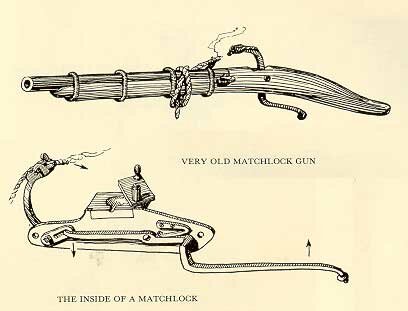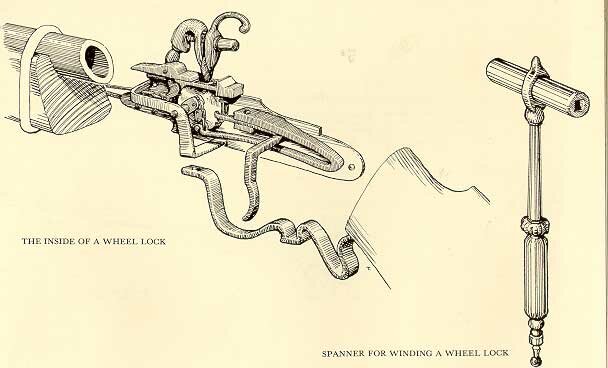Primer, being a brief overview of the evolution of firearms from matchlock to flintlock.
Before the invention of firearms, sailing ships relied on archers for protection. As firearms became perfected, the archers were replaced. By today's standards the firearms possessed a limited range, were inaccurate and unreliable. This section examines the evolution of the firearm from the matchlock to the flintlock.
The matchlock was the first type of hand held weapon possessing a charge propelled by an ignited explosive charge. The flintlock was the type of weapon most commonly encountered during the period discussed.
The Matchlock
The matchlock was mostly used in larger, shoulder fired weapons but a few pistols were made using this method. In most cases a matchlock had a slow burning fuse attached to a serpentine (cock or hammer). This was cocked back and small pan was filled with priming powder. A trigger released the serpentine dropping the fuse to the priming pan and firing the weapon. It worked poorly, if at all in the rain. The first appeared in the mid 1400s and would have been unsuitable for use on board ships.
Matchlocks were developed from the flash pan used on Hand-Goone (hand cannon) A person would light a pan of powder, by hand, which would ignite the charge to the hand cannon. . This was Hand-Goone was the first portable hand held firearm. The earliest used a simple touch hole. Later versions used a flash pan. The "hand guns were about five feet long, very heavy, often made of hollowed out log, and very unreliable. They dated from the late 1300s or early 1400s.

The Wheel-Lock
Wheel-Locks eliminated the use of a fuse of the Match-Lock by inventing something similar to a fly wheel. A small wheel of pyrites or flint was attached to a spring which was wound up like a clock's spring. The serpentine now contained a small piece of metal instead of a fuse. When the trigger was pulled the spring was released, and the wheel spun around as the serpentine made contact. This produced sparks which fell into the priming pan which ignited the main charge and fired the weapon. The first appeared around 1517.

Early 17th Century Wheel-Lock Pistol from England

Wheel-Lock Mechanism
The Snaphance
The snaphance (also spelled snaphaunce) was an improvement over the Wheel-lock. It shoed up in the 1570s. It basically put the pyrites in the serpentine which is now referred to a Dog-head or Hammer. The dog head is still wound up but now it strikes a steel plate(frizzen), which causes sparks to fall in the priming tray, thus firing the weapon. In most case the primer pan still had a pan cover separate from the frizzen. The pan cover was opened with the pull of the trigger or manually by the firer.

The Flintlock
The Flintlock was the weapon most likely encountered in the 17th-19th century. The Flintlock was first developed in France around 1612. While a few snaphaunces might have lingered, especially because of the wide use of this gun system in Scotland, it is doubtful that the Wheel-Locks would have been in use in this part of the world. The use of Wheel-Lock would have still been encountered in the South Pacific in the late 17th century, however.
The Flintlock used a doghead and frizzen similar to the Snaphaunce. The sear was enclosed in a lock plate and consisted of a tumbler which allowed the weapon to be half cocked and fully cocked. In the half cocked position the sear would drop into a deep groove which prevented the trigger from being pulled and the dog-head from dropping (a crude form of safety) . At the fully cocked position the sear dropped into a shallow groove. The sear could be pushed out of this groove by pulling the trigger. By now the frizzen and pan cover were combined into one spring loaded unit.
Before firing a weapon, the shooter would pull the doghead back until it made a noticeable click. This was the half cocked position, and was considered the safe position. A measured amount of powder was poured down the barrel, followed by wadding (patch) and ball (now called the bullet). Often to expedite the loading, loads were prepared ahead of time and wrapped in paper waddings. In this case, the wadding was torn at the powder end and the the powder poured down the barrel. Afterwards the bullet and wadding would be rammed down the barrel with the ramrod. The wadding or patch actually wraps around the ball to give it snug fit in the barrel. Typically, the ball is slighlty smaller than the barrel. In some cases if the ball was very small, more wadding would be used to make a snug fit.
By pulling the doghead back another click, the weapon would be armed and ready to fire. A pull of the trigger would, most likely result in a discharge. Because the frizzen and priming pan were now one spring loaded unit, it was now possible to load a pistol beforehand and still have it go off reliably later. The frizzen could be pulled back, primer added to the pan and then the frizzen was lowered back on top of the pan. When the trigger is pulled the doghead strikes the frizzen causing sparks and pushing open the pan at the same time, thus exposing the priming powder and causing the powder to ignite which in return fires the round.
Basic parts
- Ball or Shot
- The bullet used in a gun. Often more than one shot was loaded in a musket or pistol. A popular load was one large shot and two or three smaller pellets.
- Barrel
- The business part of a pistol or musket, Pistols were usually between 4 and twleve inches long. Muskets barrels were often 36 to 48 inches long.
- Black or Gunpowder
- Black powder which was made from saltpeter, charcoal and sulfur. There were many ways that it was made and in different strengths. Suffice it to say that if one were to use the high quality powder of today's small arms in a flintlock of the 1700's the weapon could very well blow up. Black powder was weak compared to today's standards.
- Butt or Butt Cap
- A metal cap on the bottom of a pistol's grip. On more expensive weapons, various designs were crafted in precious metals or jewels. It was often the most ornate part of a pistol with the possible exception of the lock. Once a pistol had been fired it was often turned around and used as a club. Hence a nice have butt cap would come in hand not only as a counter balance for a long barrel but also for cracking skulls.
- Doghead
- What the hammer of the pistol was originally called. It was often shaped in the form of an animal with an open mouth, in which the pyrites were placed.
- Fore-End Cap
- A cap often made of brass at the front of the wood furniture of a pistol. It was on the fore-end cap that the swivel for the rammer was often attached. It also acted as the front mount securing the barrel.
- Flints
- A type of pyrite stone used to create sparks in a flintlock weapon. Flints were hard and brittle and would have to be replaced after firing the weapon 25 or 30 times.
- Frizzen
- A piece of metal that was struck by pyrites to produce sparks.
- Lock
- The part of the pistol which includes the frizzen, doghead and the internal parts of the gun such as the sear and trigger assembly. in short it was the part that make the gun go bang.
- Priming Pan
- A small pan in which specially made priming powder was placed. The pan was just under the frizzen. The frizzen was often attached to a pan cover. When the frizzen was struck by the doghead, the pan was forced open and sparks would rain down on the powder discharging the weapon.
- Priming Powder
- Powder that was ground smaller and smoother than regular gun powder. Quite often it contained more saltpeter (Sodium Nitrate) making more volatile. Often this was the powder contained in the powder horn. Cartridges made of gunpowder and shot wrapped in paper were often prepared ahead of time and carried in a special cartridge pouch. In many instances the same powder used to fire the flintlock was used as priming powder.
- Ramrod or Rammer
- A long hard wood pole that was in a diameter slightly smaller than the barrel. It was used to ram powder and shot down the barrel of muzzle loaders. It was often attached to the bottom of the barrel by a swivel
- Touch Hole
- A hole located at the bottom of a guns barrel. in early weapons powder was poured into the touch hole and a flame was touched against the hole causing the weapon to discharge. As weapons evolved the touch hole was integrated into part of the priming pan. Touch holes would foul from burnt powder and would need to be picked open after 5 to 15 shots were fired.
- Stock
- The wood furniture of a rifle or musket or rifle. The butt-stock is the part of the stock that is pressed against the shoulder when fired.

The only author and editor of all pages on the site. Most of what I write about is based on years of book reading on the topic. My first web page was published back in 1994.